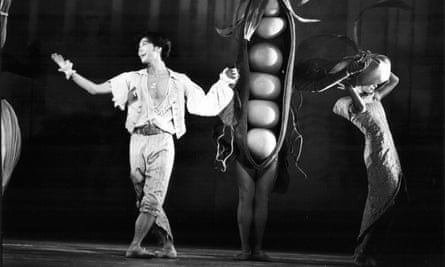The last time Twyla Tharp was working at the Royal Ballet it was 1995 and she was creating her comic Rossini ballet, Mr Worldly Wise. Now, as she returns, it’s hard to recognise that two decades have passed. The 76-year-old choreographer is wearing much the same working uniform as when I interviewed her around that time – blue jeans, crisp shirt, tennis shoes – and there’s no diminution in the sharpness of her gaze or in the crackle, and occasional acerbity, of her conversation.
Her workload is similarly unreduced. Starting at 6am with the daily physical regime that allows her, still, to try out most of her dance material on herself, Tharp is full-on busy. There are new works to create, old ones to stage, an online archive to manage, a book deadline to meet and a university course to devise. Recently Tharp presented a three-week season in New York, during which she made a 10-minute appearance with a choreographed dance lecture. Retirement is not a word you care to mention in her presence.
The work she is making for the Royal is an expanded version of her 1973 ballet As Time Goes By, a setting of the third and fourth movements of Haydn’s “Farewell” Symphony. Initially Kevin O’Hare, the Royal’s director, asked her to create a new duet for two of his virtuoso principals, Sarah Lamb and Steven McRae. And it was while Tharp was casting around for suitable music – “anything from Mendelssohn to Leonard Cohen, with Bach thrown in for good measure” – that she remembered she still had the Haydn ballet “sitting about” with half of its score still unused. “I never planned at the time that I would finish it,” she says, “but I never planned that I wouldn’t.” And as she returns to the original choreography, she’s grafting on the first two movements of the symphony, in the form of an extended pas de deux.

Lamb and McRae will be dancing through 14 minutes of music “with all guns on deck”, and Tharp is unstinting in her appreciation not just of their stamina and technique, but also for the speed with which the dancers have absorbed the complexities of her choreography. “I set the duet in 10 days, then left them to work on it independently. Now that I’m back, the difference is night and day. Steven and Sarah have done a phenomenal job of owning the material and fixing whatever small flaws there might have been. Now I’m shifting the accents, which is driving them crazy, but it’s all for the better.”
While she thinks the two dancers are “extraordinary”, Tharp also views them as products of the Royal’s unusually open and supportive dynamic. “I like this company very much. It feels very comfortable and productive to me. It’s very grounded in the past but it consistently moves forward, and that’s not true of a lot of companies.”
Certainly she contrasts the atmosphere at the Royal with the welcome she received at the Joffrey Ballet, where she first choreographed As Time Goes By. Although Tharp had studied ballet since childhood, she had made her reputation as a modern dance maker, and in 1973 it was unusual for a contemporary choreographer to create work for a classical company, especially if she was a woman. The director, Robert Joffrey, gave Tharp every encouragement but she recalls getting “sizeable flak from the men in the company, who didn’t want to be told what to do by a woman”. She shrugs off the memory. “I never thought of myself as a ‘woman choreographer’ or as a ‘modern choreographer’ – I was simply making dances.”
To outward appearances at least, Tharp has always operated according to her own formidable sense of purpose. She tells the story of the first time she took a modern dance class, as a student at Barnard College, New York, in 1961: “I walked in and the teacher was telling the class to dance a sunrise. I walked straight out again and went to the president to tell her I hadn’t come to college to dance sunrises.”
Dismissing most of the teachers at Barnard, Tharp sought out others and during her formative years she was taking classes with jazz legend Luigi, Merce Cunningham and even an ageing Martha Graham. This scope has left its mark, for while the first pieces she made were austere and minimalist they have since embraced a joyous diversity of music (ranging from Jelly Roll Morton to the Beach Boys, from Beethoven to Philip Glass) and their scintillatingly fast dance material has distilled a range of styles.
Tharp has created huge successes, including the entrancingly rigorous Fugue (Bach’s musical themes turned into an angelic silent disco) and the cascading intensities of In the Upper Room. But there have been some failures too, including a Bob Dylan dance musical that flopped ignominiously. Either way, she claims to remain strictly objective about her work. “When I finish a piece I either see it as completely done or I see that it doesn’t quite work and why.” She dates her critical certainty to the years spent working at her parents’ drive-in. “I never used to get emotionally pulled into the films. I was always criticising them from the outside, usually from the point of view that if they were boring, I would have to be busy making hot dogs for the audience.”

When I ask what kind of art does pull her in, Tharp replies: “Nothing.” A half-second later she relents. “Music. Music has always connected to me emotionally.” She says it has always been necessary, when she choreographs a score, that she keeps hold of that first feeling of being “swept up in it”. To achieve that end, she will subject the score to a forensic analysis, working out how it is built, how it can be embodied as dance. She does as much of her “homework” as possible before meeting her dancers. “I never go into the studio empty-handed. I don’t ever say to the dancers, ‘What do you think, what can you try?’ I have neither the arrogance nor the disrespect to do that.”
Tharp’s self-reliance is partly driven by the fact that she’s often working with new dancers, for new companies, and prefers to meet them properly prepared, on her own terms. I ask if her life feels professionally lonely. She doesn’t hesitate: “Of course. It’s always been lonely. First thing every morning you have to confront your own intentions. You have that rehearsal at 12, and you either have what you hope might be a good idea or you straight up don’t have an idea in your head – and you have to fix that.”
When the pressure gets too much she turns to Agatha Christie. “I’ve just found seven new mysteries that I haven’t read and I’m so grateful for them. It’s how I try to keep myself from thinking. Christie is phenomenal, she’s absolutely consistent. I always say that the structure of her mysteries is as exact as a sonnet. She has it clocked which paragraph, which page, the twist has to happen.”
Tharp admits that her working day leaves her little energy for seeing dance shows other than her own (“When you get up at six, you’re not going out at night”). In addition to planning future projects – which she prefers not to discuss, as “ideas always change” – she has an extensive back catalogue to manage and preserve. Much of it is going online. Tharp began to videotape the creation of her dances back in 1969 and now has over 500 hours of material that she’s keen to edit into an illustration of her choreographic logic. “Dances aren’t steps,” she says. “They’re thinking, they’re thoughts.”
Much of that old choreography, though, is still being performed on stage, both by her own company and others, and Tharp looks pleased when I tell her that, having watched a fragment of the Haydn ballet online, I was genuinely surprised by how current it looks. “It’s a confirmation of sorts when the old pieces live,” she says. “Back in 1973, people gave me flak because that work didn’t look classical enough. I said, ‘This may not be your version of ballet but “classical” is simply what survives.’ That’s why I called the ballet As Time Goes By.”
- The Illustrated Farewell is part of a mixed programme at the Royal Opera House, London, 6-17 November. Box office: 020-7304 4000

Comments (…)
Sign in or create your Guardian account to join the discussion